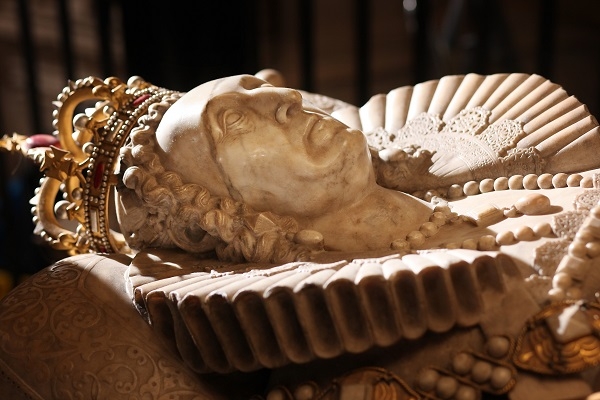from Delia
When winter snows upon thy golden hairs,
And frost of age hath nipped thy flowers near;
When dark shall seem thy day that never clears,
And all lies withered that was held so dear;
Then take this picture which I here present thee,
Limned with a pencil not all unworthy;
Here see the gifts that God and Nature lent thee;
Here read thyself, and what I suffered for thee.
This may remain thy lasting monument,
Which happily posterity may cherish;
These colours with thy fading are not spent;
These may remain, when thou and I shall perish.
If they remain, then thou shalt live thereby;
They will remain, and so thou canst not die.
Nicholas Hilliard’s miniature portraits are bewitchingly beautiful. Look at one today and it’s easy to feel that we connect with the subject in a way we don’t with a full-size painting. The informality of the poses helps (like a snapshot taken with a camera-phone) but so does the size. Their delicate ingenuity seems almost too fragile to have survived four hundred years. Whilst many ingenious lovely things are gone, these jewel-like shadows of the dead blaze on, like butterflies hovering over the edge of some great storm.
The Elizabethans of the 1590s were hungry for artists’ promises of a permanence that would survive them. Aristocratic patrons paid for pictures like Hilliard’s and savoured the work of poets who argued that, whilst the beauties of the body would soon be dust, the beauties of a good poem would live forever. And if that poem is about you, then you too will live forever. In a way.
Like Shakespeare, Samuel Daniel explicitly worked this promise into his own sonnets. As he tells Delia (the subject and the addressee of his sonnet cycle) – ‘If they remain, then thou shalt live thereby’. A good sonnet is like a good miniature. Small and well-crafted, it preserves the essential features of its subject and transmits them to future generations. Daniel pushes this comparison until he blurs the boundaries between picture and poem. He writes of ‘this picture which I here present thee’ which he has ‘limned with a pencil’ but within which Delia is told to ‘read thyself’.
‘This picture’, we realise, is actually the poem, or the whole cycle of over a hundred sonnets to which it belongs. But Daniel isn’t just using a metaphor to describe his poems; he’s suggesting a deep affinity between painting and writing. Pictures can be ‘read’, and poems can have ‘colours’ which won’t fade (unlike a painting whose pigments can change over time). Another form of art – sculpture – is added when Daniel describes his poems as Delia’s ‘lasting monument’. This is reminiscent of the elaborate funeral monuments erected for rich Elizabethans, which often include life-size effigies coloured with paint. Here is another way art can preserve the image of someone long after their death.
Daniel’s subtle slide between these different forms of artwork creates a sense of their equivalence and interchangeability. Something seems to lie behind them, holding them all together. What they have in common, of course, is Delia. Painting, poem, and effigy are all images of her. They all capture and preserve, in their different ways, some truth about her.
This way of understanding art owes a lot to the neo-platonic philosophy which was fashionable in the late sixteenth century. Drawing on what they considered to be Plato’s thought, followers of this tradition believed that the things we experience in the world are all manifestations of ‘Ideas’. These are immaterial and unchanging archetypes which exist beyond the material world. The Ideas are a sort of set of templates for everything which exists.
Writers and artists drew on these theories to explain their own practices. They argued that what they were doing was giving material form to Ideas of things like ‘the Good’ or ‘Beauty’. This is what Samuel’s sonnet cycle is meant to do. The title signals this – Delia is an anagram of ‘Ideal’. This was the ambitious extent of the promises some artists were making. Not only could they make beautiful things which would outlive their subjects, but they could also make visible contact with a world of unchanging truth.
These are theories we find difficult to accept today. Like the unquestioning Christian faith of the Elizabethans, this is a way of living which we can recognise but probably never share. And yet the beauty of Hilliard’s portraits and of Daniel’s sonnets remains. I think they leave us with an almost-instinct which is almost true – something will survive of us.






Comments